|
 Powerful 11-parallel push-pull output stage delivers linear power into
loads as low as 1 ohm Powerful 11-parallel push-pull output stage delivers linear power into
loads as low as 1 ohm |
 Current feedback circuit topology combines ex-cellent sound quality with
total operation stability Current feedback circuit topology combines ex-cellent sound quality with
total operation stability |
 Bridged connection mode allows upgrading to true monophonic amplifier Bridged connection mode allows upgrading to true monophonic amplifier |
 Massive Super Ring toroidal transformer rated for 1.5 kVA Massive Super Ring toroidal transformer rated for 1.5 kVA |
 Printed circuit boards made from Teflon material Printed circuit boards made from Teflon material |
 Balanced inputs Balanced inputs |
| * Teflon is a registered trademark of DuPont USA. |
|
|
An experience in excellence - Witness a stereo power amplifier capable
of delivering 1000 watts into 1-ohm loads. Constant drive voltage principle
ensures total speaker control. High-performance power transistors connected
in an 11-parallel push-pull configuration deliver linear power even into
extremely low impedances. Current feedback topology guarantees stable operation
up to ultra high frequencies. Performance specs fully cover the requirements
of new-generation program sources such as SACD and DVD-Audio.
The Accuphase monophonic power amplifier M-2000 and the pure class A stereo
power amplifier A-50V have been hailed as stunning achievements, both for
their outstanding technical performance and impeccable sound quality. While
these two models employ somewhat different circuit topology, their underlying
philosophy is the same: to provide extremely low output impedance (Note
1), and to be capable of supplying a constant drive voltage at all times
(Note 2).
The P-1000 achieves these same goals with even more sophisticated technology.
It is a stereo power amplifier that attains yet another dimension of sonic
excellence. It is perfect for the new generation of ultra high quality
program sources such as SACD and DVD-Audio. Regarding frequency response
(0.5 Hz - 150 kHz), S/N ratio, and all other perfor-mance aspects, the
P-1000 is fully ready for the requirements of the future.
The output uses 11 pairs of high-power transistors in each channel, arranged
in a parallel push-pull configuration. These devices are mounted to mas-sive
heat sinks that provide efficient dissipation of thermal energy. Power
linearity is maintained down to ultra low impedance loads of 1 ohm. By
using the P-1000 in bridged mode, the user can create a mono amplifier
with even more impressive power reserves. The power supply features a highly
efficient "Super Ring" toroidal transformer and large filtering
capacitors.
Current feedback topology combines total operation stability with excellent frequency response, while requiring only minimal amounts of negative feedback.
Accuphase research has shown that the material used for printed circuit boards has a deci-sive influence not only on electrical characteristics but also on the sonic end result.
The P-1000 uses a Teflon material with extremely low dielectric constant and low loss, resulting in more transparent sound.
The P-1000 is a power amplifier that already impresses by its sheer physical
presence. But more importantly, it brings music to life with a dynamic
impact and richness of detail that must be heard to be believed.
|
Note 1 The reasoning for low amplifier out-put impedance
The load of a power amplifier, namely the loud-speaker, generates a counterelectromotive force that can flow back into the amplifier via the NF loop.
This phenomenon is influenced by fluctuations in speaker impedance, and in-terferes with the drive performance of the amplifier.
The output impedance of a power amplifier should therefore be made as low as possible by using output devices with high current capability.
This absorbs the counterelectromotive force generated by the voice coil and prevents the occurrence of intermodulation distortion.
Note 2 The constant drive voltage principle
Even in the presence of a load with wildly fluctuating impedance, the ideal power amplifier should deliver a constant voltage signal to the load.
When the supplied voltage remains constant for any impedance, output power will be inversely proportional to the impedance of the load.
A conventional amplifier can be easily made to operate in this way down to a load impedance of about 4 ohms.
At 1 ohm, how-ever, eight times the output of an 8-ohm load is called for, which can only be sustained by an extremely well designed and capable output stage and a highly robust and powerful power supply section.
To build such an amplifier is a task that requires not only considerable experience and resources but also a thor-ough rethinking of basic principles.
|
Modular power units in 11-parallel push-pull configuration deliver linear
output: 1,000 watts/ ch. into 1 ohm, 500 watts/ch. into 2 ohms, 250 watts/ch.
into 4 ohms, 125 watts/ch. into 8 ohms
|
The output stage uses high-power transistors with a rated collector dissipation of 130 watts and collector current of 15 A. These devices have excellent frequency response, current amplification linearity, and switching characteristics. The transistors are arranged in an 11-parallel push-pull configuration for ultra-low impedance and are mounted on a massive heat sink made from diecast aluminum. This assures effective heat dissipation and allows the amplifier to effortlessly handle very low impedances. Power linearity is maintained down to loads as low as 1 ohm, which demonstrates the impressive capa-bilities of this amplifier. Figure 1 shows the output/voltage characteristics at various load impedances. It can be seen that output voltage remains nearly constant regardless of load, which means that output current increases linearly.
|
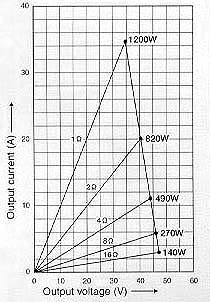
Figure 1
|
Current feedback circuit topology prevents phase shifts
The P-1000 employs the so-called current feedback principle. Figure 2 shows
the operating principle of this circuit. At the sensing point of the feed-back
loop, the impedance is kept low and current detection is performed. An
impedance-converting amplifier then converts the current into a voltage
to be used as the feedback signal. Since the impedance at the current feedback
point (current adder in Figure 2) is very low, there is almost no phase
shift. Phase compensation can be kept to a minimum, resulting in excellent
transient response and superb sonic transparency. Figure 3 shows frequency
response for different amplifier. The graphs demonstrate that response
remains uniform over a wide range.
|
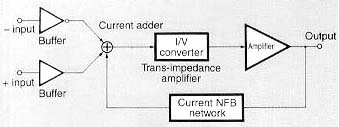
Figure 2
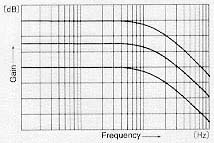
Figure 3
|
Bridged mode creates a true monophonic amplifier with 2000 watts into 2
ohms, 1000 watts into 4 ohms, or 500 watts into 8 ohms
Bridged operation means that two amplifiers are driven by the same signal
voltage but with opposite phase. The P-1000 provides a switch arrange-ment
for bridged operation of its two channels, which turns the unit into a
high-grade monaural amplifier with even higher output capability.
Printed circuit boards made from Teflon material (glass cloth fluorocarbon
resin) with low dielectric constant and low loss
The printed circuit boards consist of a glass cloth fluorocarbon resin
material which has a stable, low dielectric constant as well as superior
heat resistance and high-frequency characteristics. Since printed circuit
boards inevitably act to a certain extent as a dielectric, it is vital
to choose a material that provides all the required physical properties
while having a low dielectric constant. The low dielectric constant results
in speedier signal propa-gation, and low losses mean further enhanced signal
purity. S/N ratio also is excellent.
* Teflon is a registered trademark of DuPont USA.
All major signal paths gold-plated
High-purity copper is commonly used in audio components for signal path
lines. The P-1000 goes one step further by providing gold-plating. This
includes not only the copper traces on printed circuit boards but also
ground bars carrying large ripple currents, bus bars providing current
to the power transistors, input jacks, and speaker terminals. This thorough
approach results in a distinct sonic improvement. |
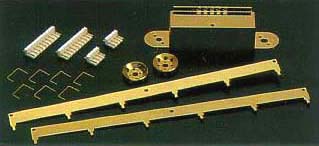
|
Robust power supply with "Super Ring" toroidal transformer and
high filtering capacity
The P-1000 features a large toroidal power transformer with a rating of
1.5 kVA. Toroidal power transformers use heavy-gauge copper wiring on a
doughnut-shaped core. This results in low impedance and high efficiency,
while allowing compact dimensions. In particular, the "Super Ring"
transformer used in the P-1000 has the following advantages:
|
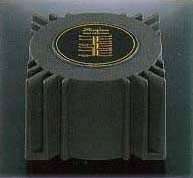
|
|
1. A near-circular core allows near-circular coil windings with high packing density, resulting in low weight, low losses, low leakage flux under actual load conditions, and minimum vibrations.
2. Smaller ferrite core diameter and copper windings with high specific gravity mean low ferrite losses and low inrush current.
Two ultra-large aluminum electrolytic capacitors rated for 56.000 micro F each provide more than ample filtering capacity and allow the amplifier to effor tlessly handle any power demand.
|
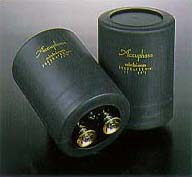
|
Extra large speaker terminals
The oversize speaker terminals accept also very heavy-gauge speaker cable.
The terminals are made of extruded high-purity brass material and are gold-plated
for utmost reliability and minimum contact resistance. Molded caps provide
proper insulation.
|
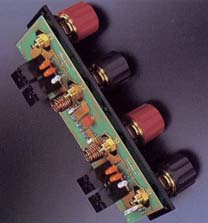
|
Easy switching between dual mono operation and bridged connection
A mode selector on the rear panel makes it simple to switch between dual
mono, stereo, or bridged operation. The dual mono position is useful for
example to drive a center woofer in mono, or to obtain the same signal
from both speaker outputs for driving a bi-amped speaker setup.
|

|
Balanced connection reliably blocks induced noise
Balanced signal transmission means that two signal lines are used which
carry the same signal with opposite phase. On the receiving side, the signals
are mixed. Since any noise interference that has arisen during transmission
will be present in both lines with identical phase, such noise is canceled
out, leaving only the pure original signal. Balanced connection therefore
keeps the signal transfer free from any kind of interference.
Large direct-reading analog power meters
The large analog power meters have a peak hold function which lets the
user easily monitor the output level of the rapidly fluctuating music signal.
Thanks to logarithmic compression, the meters cover a wide dynamic range.
Switches for meter on/off and illumination are also provided.
|
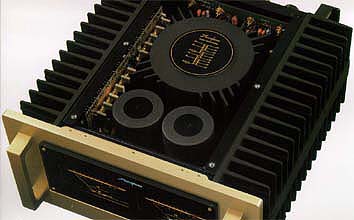
|
|
* Guaranteed specifications are measured according to EIA standard RS-490.
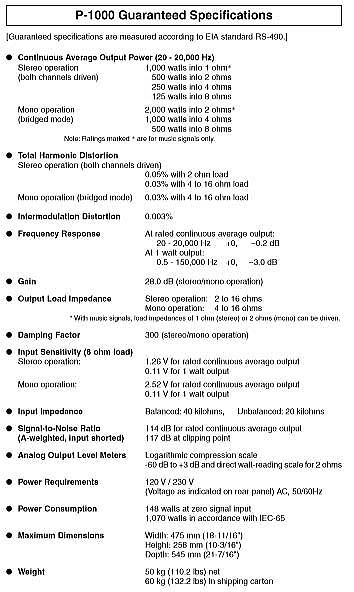
* Specifications and design subject to change without notice for improvements. |
|
|
|
|
|